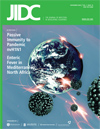Frequency of Scabies in Iraq: Survey in a Dermatology Clinic
DOI:
https://doi.org/10.3855/jidc.144Keywords:
scabies, frequency, prisoner, IraqAbstract
Background: The burden of scabies is highest in tropical countries, but recent data from Iraq are scanty.
Objective: To estimate the frequency of scabies in patients of a dermatology clinic in central Iraq.
Methodology: The study was conducted in Tikrit (Iraq), between May 2007 and February 2008. A total of 1,194 patients presenting to a dermatology clinic were included in the study.
Results: During the study period, 132 [1.1%] patients with scabies were identified. The frequency was 13.5% in males and 8.6% in females [P = 0.007]. Frequency in children was 15.6% and 9.8% in adults [P = 0.007]. About 91% of cases were younger than 45 years. The treatment of scabies cases with 5% permethrin cream resulted in a cure rate of 80.3% following a single application, and was increased to 95.5% after a second application. Cure was achieved in all cases after a third application.
Conclusion: Prevalence of scabies was high in a dermatology clinic, and prisoners were identified as high-risk group. Mass treatment of scabies either by oral ivermectin or topical permethrin is suggested.
Downloads
Published
How to Cite
Issue
Section
License
Authors who publish with this journal agree to the following terms:
- Authors retain copyright and grant the journal right of first publication with the work simultaneously licensed under a Creative Commons Attribution License that allows others to share the work with an acknowledgement of the work's authorship and initial publication in this journal.
- Authors are able to enter into separate, additional contractual arrangements for the non-exclusive distribution of the journal's published version of the work (e.g., post it to an institutional repository or publish it in a book), with an acknowledgement of its initial publication in this journal.
- Authors are permitted and encouraged to post their work online (e.g., in institutional repositories or on their website) prior to and during the submission process, as it can lead to productive exchanges, as well as earlier and greater citation of published work (See The Effect of Open Access).








